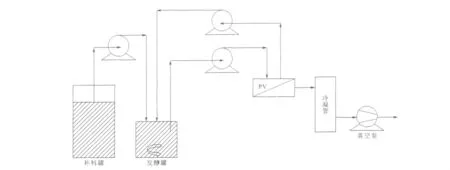渗透汽化技术在生物丁醇生产中的应用进展
2013-10-15王风芹宋安东
王风芹,程 翔,谢 慧,宋安东
(河南农业大学生命科学学院,河南 郑州450002)
随着化石燃料消费量的急剧增长,能源危机、环境安全和温室效应等问题日益突出,新型可再生能源的开发迫在眉睫。丁醇(Butanol)是一种优良的化石燃油替代品,具有能量密度较高、可以任意比例与汽油混合使用、腐蚀性小、便于管道运输等优点[1]。然而,由于发酵过程中产物丙酮(Acetone)、丁醇和乙醇(Ethanol)(又称总溶剂或ABE)对微生物的生长代谢产生抑制,使得发酵液中总溶剂浓度一般维持在23g·L-1以下,其中丁醇一般不超过13g·L-1[2]。如何提高发酵产量、降低提纯成本是生物丁醇发酵生产亟需解决的难题之一。
渗透汽化技术是借助渗透汽化膜的选择透过性使待分离组分透过膜并在膜的另一侧汽化,收集于冷凝装置,达到分离的目的[3]。与传统的分离技术(如蒸馏、吸附、气提、液液萃取)相比,渗透汽化技术不仅能够实现产物的分离与浓缩,且选择性高、能耗低[4],可降低后续成本,还可保证产品纯度。近年来,渗透汽化技术在生物丁醇发酵生产方面的应用受到了广泛关注。
1 渗透汽化透水膜及其在丁醇发酵中的应用
1.1 渗透汽化透水膜
渗透汽化膜按其专一性可分为优先透水膜(亲水膜)和优先透醇膜(疏水膜)两种类型。渗透汽化透水膜利用膜成分对水分子的扩散性,使水透过膜而醇类物质不能通过,起到精馏物料的作用。渗透汽化透水膜按所用材料不同可分为有机膜、无机膜和有机/无机复合膜几种类型,其主要类型及特性见表1 。现阶段,优先透水膜的工业应用主要集中于聚乙烯醇(PVA)及其改性材料方面,但仍有新材料不断被发现和研究。
1.2 渗透汽化透水膜在丁醇发酵中的应用
渗透汽化透水技术可取代传统共沸精馏,降低能耗。目前的研究和应用主要集中于无水乙醇的生产。德国GFT公司(现属瑞士Sulzer Chemtech公司)率先成功将渗透汽化技术应用于无水乙醇的生产,并于1988年在法国Betheniville建成世界上第一个大型的渗透汽化脱水制无水乙醇工厂,其生产能力为150 000 L·d-1,产品含水量小于2g·L-1[20]。我国也于20世纪80年代开始该方面的研究,其中清华大学与山东蓝景膜技术有限公司合作设计并建成了几套燃料乙醇渗透汽化脱水生产设备[21],其成本比传统的精馏法降低了20%以上。自2003年我国渗透汽化有机物脱水膜技术实现工业化以来,已实现了膜制备、膜组件设计制造和膜工程实施的完全自主知识产权;但与国外工业化程度相比,还存在工业化推广应用速度过慢、企业规模小、生产成本高等不足[22]。
燃料丁醇脱水技术在借鉴了燃料乙醇脱水技术的基础上也取得了较快的发展。以目前应用最广的聚乙烯醇(PVA)为例,通过选取不同材料作为其支撑层就能制成分离效果显著的渗透汽化透水膜。Sridhar等[23]利用PVA与聚酰胺纤维通过戊二醛交联制备复合膜,该膜在27.6%水-异丁醇溶液中的分离因子为26.5,通量为3.07kg·m-2·h-1。Peters等[15]将超薄的PVA膜附着在中空纤维陶瓷支撑层上,增强了膜的稳定性,在80℃、5%水-正丁醇条件下,通量达0.8~2.6kg·m-2·h-1,分离因子为500~1000。将该膜置于80℃工作180d后,水的通量从1kg·m-2·h-1提高到1.4kg·m-2·h-1,而分离因子却从450降到300;置于100℃工作14d,分离因子下降更为显著,由300下降到25。这可能是由PVA主链上马来酸的减少引起交联度的下降所致[24]。

表1 渗透汽化透水膜主要材料及其特性Tab.1 The features of different hydrophilic pervaporation membrane materials
由于PVA与大多数聚合物膜一样,不能在较高温度和酸性条件下正常工作,因此,研制性能更好的新型材料、尤其是利用无机膜耐高温和溶剂的优点开发有机/无机复合膜逐渐成为人们关注的热点。Castricum等[19]利用一种新型的有机/无机复合膜进行脱水实验,所用的有机前体为1,2-二(三乙氧基硅基)乙烷(BTESE),通过溶胶-凝胶法制得100nm 的BTESE-SiO2膜,由于将弱稳定性的硅氧键替换成更为稳固的硅碳键,使得膜在高温下依然能够持续工作。该膜在150℃、5%水-正丁醇条件下,通量达20kg·m-2·h-1,分离因子超过4000;在持续540d的连续实验中依然能够很好地保持选择透过性,并且能够耐受较低pH值的溶剂环境。van Veen等[25]测试了商品化的 HybSi○R膜的渗透汽化透水性能,发现Hyb-Si○R
膜的工作温度可以达到190℃并且可以适应pH=2的有机惰性溶剂;可以在150℃下连续正常工作1000d。HybSi○R膜的试验参数已经符合工业化的要求,为燃料丁醇渗透汽化的工业化奠定了基础。
此外,近年来研究的新型膜,如聚酰胺-酰亚胺(PAI)/聚酰亚胺(PI)双层中空纤维膜[26]、以陶瓷为支撑层的聚乙烯醇壳聚糖复合膜[27]、聚酰胺-酰亚胺膜表面接枝环糊精膜[28]、热重排聚苯唑膜[29]等为渗透汽化透水膜应用于生物燃料丁醇生产提供了更为广泛的选择空间。
2 渗透汽化透醇膜及其在丁醇发酵中的应用
2.1 渗透汽化透醇膜
渗透汽化透醇膜技术是通过选择合适的膜材料对目标分离物进行单一分离,从而将产物从水相中分离出来。该技术要求膜材料与制备工艺更加完善,至今尚未应用于工业化生产。由于优先透醇膜材料需要具有极性低、表面能小以及溶解度小等特点,其材料选取范围受到一定的限制。常用的渗透汽化透醇膜类型及其特性见表2 。

表2 渗透汽化透醇膜主要材料及其特性Tab.2 The features of different hydrophobic pervaporation membrane materials
聚二甲基硅氧烷(PDMS)是最具代表性的亲有机物聚合膜材料,在渗透汽化透醇膜中应用最为广泛,许多渗透汽化透醇膜的研究都是围绕对PDMS进行共聚、填充、交联、共混以及表面改性等,以期提高其机械强度和选择性,力求通过在多孔支撑体上制备超薄无缺陷的PDMS膜层并向PDMS基质中掺杂疏水性的无机粒子从而使之更适用于工业生产。Liu等[44]研究了温度、料液浓度、料液流速和渗透时间对PDMS/陶瓷复合膜渗透性能的影响,发现升高温度或者提高料液中丁醇浓度会使渗透通量上升,但分离因子迅速降低。Zhou等[34]研究交联剂乙烯基三甲氧基硅烷(VTMS)对PDMS/Silicalite-1杂化膜物理特性、渗透汽化特性的影响时发现,交联剂作用于杂化膜的非选择性空隙,有助于提高膜的选择性和渗透通量。Jadav等[45]研究了PDMS膜厚度与通量之间的关系,发现膜越薄,其高分子主链的聚合体和结晶数量越多,这种松散结构可能导致了渗透汽化过程中的高通量和低选择性。目前商业化的PDMS膜(Pervap1060,GFT)在40℃、1%丁醇-水溶液中的总通量为300g·m-2·h-1,分离因子为27[46]。
此外,越来越多的材料被用于渗透汽化透醇膜的研究和开发中。Ikegami等[47]制成的硅橡胶表面涂层沸石膜,30℃时1g硅沸石可以吸附95mg乙醇、100 mg丙酮和120mg丁醇。Beltran等[43]利用油醇-聚辛基甲基硅氧烷液膜在60℃、2.5%丁醇-水体系中进行渗透汽化实验,分离因子为279,渗透通量达95.9 g·m-2·h-1;发酵液体系中,丁醇分离因子达76.4,同时液膜中仅有不到4%的成分流失。
2.2 渗透汽化透醇膜在丁醇发酵中的应用
将渗透汽化透醇膜与发酵耦合,可对产物进行原位分离,减少产物抑制,实现连续发酵。图1为常见的发酵耦合渗透汽化装置流程简图。
Groot等[48]将硅橡胶膜组件与利用葡萄糖发酵生产丁醇-异丙醇过程相耦合,原位分离发酵产物,与未耦合过程相比,葡萄糖的转化率和溶剂产生率均提高了65%~70%。童灿灿[49]以 PDMS(Tetraethylorthosilicate)/PVDF渗透汽化膜组件与丁醇分批发酵耦合,反应体系总溶剂产率从传统分批发酵的0.19g·L-1·h-1提高至0.44g·L-1·h-1,葡萄糖的利用速率由0.49g·L-1·h-1提高至0.75g·L-1·h-1,透过液的总溶剂质量分数达28%左右。Yen等[50]研究发现,PEBA膜耦合分批发酵比不耦合发酵产量提高了43%,持续24h补料发酵的丁醇产量也比未耦合发酵提高了39%。Hecke等[51]研究丁醇连续发酵时发现,耦合PDMS渗透汽化膜进行同步分离发酵后,丁醇产率从0.13g·L-1·h-1提高到0.3g·L-1·h-1。

图1 连续/半连续细胞循环渗透汽化耦合发酵装置简图Fig.1 The schematic diagram of continuous/semicontinuous fermentation coupled with pervaporation system and cell recycle
尽管渗透汽化与发酵耦合技术具有选择性高、能耗低等优点,但分离过程中膜污染导致分离通量和分离因子下降是制约该技术发展的瓶颈。Qureshi等[52]研究发现,耦合实验结束后,渗透汽化膜通量基本保持不变,分离因子却下降了2~3倍。Liu等[36]研究PDMS-陶瓷膜与ABE发酵耦合过程发现,活细胞会吸附于膜表面,使膜的性能降低,但是通过水洗可以使膜性能得以恢复。Vane[53]认为渗透汽化工艺需要在提高能量利用效率、减少渗透汽化设备费用、增强膜的持久性和抗污染能力、优化与发酵耦合过程等方面进行改进才具有经济优势。
3 结语
生物质发酵制备燃料丁醇在今后的研究和应用中具有重要的战略意义,为加快渗透汽化技术在生物燃料丁醇生产中的应用进程,尚需解决以下两个关键问题:
(1)提高渗透汽化膜的通量、分离因子和稳定性。增加支撑层制备超薄复合层膜等,以提高渗透通量;向聚合物基质中掺杂无机纳米粒子等,以提高膜的选择性(即分离因子);利用共聚、交联、表面改性等手段,以提高膜的使用寿命;开发新型膜材料,以提高膜的热稳定性。
(2)发酵过程产生的副产物以及菌体细胞对渗透汽化膜性能的影响。目前的研究主要集中于利用水-丁醇体系衡量渗透汽化膜性能的优劣,而丁醇发酵培养基中含有大量的营养成分、菌体细胞、副产物如乙酸和丁酸、产物ABE等。因此,需要综合多方面的研究,优化膜组件和耦合过程工艺的操作参数,深入研究膜污染作用机理,才能对渗透汽化膜性能进行较为完整的评价。
总之,渗透汽化技术显示了其得天独厚的应用价值,而将渗透汽化技术应用于生物质发酵制备丁醇的工艺具有高效、环保的优势,是切实可行的。随着研究的不断深入,其工业化应用必将在不远的将来得以实现。
[1]王风芹,楚乐然,谢慧,等.纤维燃料丁醇研究进展[J].生物加工过程,2009,7(1):1-6.
[2]高凯,李云,杨秀山.影响丙酮丁醇发酵的主要因素及解决方案的研究进展[J].生物质化学工程,2011,45(2):45-50.
[3]Ezeji T,Qureshi N,Blaschek H P.Butanol fermentation research:Upstream and downstream manipulations[J].Chem Rec,2004,4(5):305-314.
[4]Ezeji T,Mline C,Price N D,et al.Achievements and perspectives to overcome the poor solvent resistance in acetone and butanol-producing microorganisms[J].Applied Microbiol Biotechnol,2010,85(6):1697-1712.
[5]蔡邦肖,张佩琴.聚乙烯醇渗透汽化分离膜的研究进展[J].华东理工大学学报(自然科学版),2006,32(2):235-240.
[6]Jiang L Y,Wang Y,Chung T,et al.Polyimides membranes for pervaporation and biofuels separation[J].Prog Polym Sci,2009,34(11):1135-1160.
[7]Chapman P D,Oliveira T,Livingston A G,et al.Membranes for the dehydration of solvents by pervaporation[J].J Membrane Sci,2008,318(1/2):35-37.
[8]朱智慧,钱锦文.壳聚糖膜在渗透汽化领域的研究进展[J].材料科学与工程学报,2008,26(2):308-311.
[9]沈江南,陈兵,阮惠敏,等.海藻酸钠渗透汽化分离膜的研究进展及展望[J].现代化工,2008,28(12):19-24.
[10]Ohya H,Matsumoto K,Negishi Y,et al.The separation of water and ethanol by pervaporation with PVA-PAN composite mem-branes[J].J Membrane Sci,1992,68(1/2):141-148.
[11]金喆民,王平,赖桢,等.壳聚糖-聚磷酸钠聚离子复合物渗透汽化膜研究(Ⅱ).聚合条件和操作条件对膜分离性能的影响[J].膜科学与技术,2003,23(3):32-35.
[12]颜正朝,宋军,林晓,等.沸石分子筛膜的合成与应用[J].石油化工,2004,33(9):891-900.
[13]Jean C,Charles W R E,Wim G H,et al.Long-term pervaporation performance of microporous methylated silica membranes[J].Chem Commun,2004,(7):834-835.
[14]曹绪芝,平郑骅.聚乙烯基咪唑/陶瓷复合膜的渗透汽化性能[J].化学学报,2008,66(7):803-809.
[15]Peters T A,Poeth C H S,Benes N E,et al.Ceramic-supported thin PVA pervaporation membranes combining high flux and high selectivity,contradicting the flux-selectivity paradigm[J].J Membrane Sci,2006,276(1/2):42-50.
[16]Huang Z,Guan H,Tan W,et al.Pervaporation study of aqueous ethanol solution through zeolite-incorporated multilayer poly(vinylalcohol)membranes:Effect of zeolites[J].J Membrane Sci,2006,276(1/2):260-271.
[17]Filiz U N,Hacer D,Nilufer D H.Pervaporation of ethanol/water mixtures using clinoptilolite and 4Afilled sodium alginate membranes[J].Desalination,2012,300:24-31.
[18]Sun H L,Lu L Y,Chen X,et al.Surface-modified zeolite-filled chitosan membranes for pervaporation dehydration of ethanol[J].Appl Surf Sci,2008,254(17):5367-5374.
[19]Castricum H L,Kreiter R,van Veen H M,et al.High-performance hybrid pervaporation membranes with superior hydrothermal and acid stability[J].J Membrane Sci,2008,324(1/2):111-118.
[20]Rapin J L.The Betheniville Pervaporation Unit.The First Large Scale Productive Plant for the Dehydration of Ethanol:Proceedings of Third International Conference on Pervaporation Process in the Chemical Industry,Nancy France,September 19-22,1988[C].Englewood,NJ,USA:Bakish Material Corporation,1988.
[21]江冠金,陈翠仙,张庆武,等.渗透汽化技术在燃料乙醇生产中的应用[J].现代化工,2008,28(Z2):47-50.
[22]李继定,展侠,葛洪,等.渗透汽化和汽体渗透膜技术应用及其浮浅思考[J].膜科学与技术,2011,31(3):135-139.
[23]Sridhar S,Smitha B,Reddy A A.Separation of 2-butanol-water mixtures by pervaporation through PVA-NYL 66blend membranes[J].Colloid Surface A,2006,280(1/3):95-102.
[24]Peters T A,Benes N E,Keurentjes J T F.Hybrid ceramic-supported thin PVA pervaporation membranes:Long-term performance and thermal stability in the dehydration of alcohols[J].J Membrane Sci,2008,311(1/2):7-11.
[25]van Veen H M,Rietkerk M D A,Shanahan D P,et al.Pushing membrane stability boundaries with HybSi○Rpervaporation membranes[J].J Membrane Sci,2011,380(1/2):124-131.
[26]Wang Yan,Goh S H,Chung T S,et al.Polyamide-imide/polyetherimide dual-layer hollow fiber membranes for pervaporation dehydration of C1-C4alcohols[J].J Membrane Sci,2009,326(1):222-233.
[27]Zhu Y X,Xia S S,Liu G P,et al.Preparation of ceramic-supported poly(vinyl alcohol)-chitosan composite membranes and their applications in pervaporation dehydration of organic/water mixtures[J].J Membrane Sci,2010,349(1/2):341-348.
[28]Wang Y,Chung T S,Wang H.Polyamide-imide membranes with surface immobilized cyclodextrin for butanol isomer separation via pervaporation[J].AIChE J,2011,57(6):1470-1484.
[29]Ong Y K,Wang H,Chung T S.A prospective study on the application of thermally rearranged acetate-containing polyimide membranes in dehydration of biofuels via pervaporation[J].Chem Eng Sci,2012,79:41-53.
[30]申屠佩兰,邢卫红.膜分离技术在生物发酵法生产燃料乙醇中的应用进展[J].食品与发酵工业,2008,34(10):120-126.
[31]Fadeev A G,Selinskaya Y A,Kelley S S,et al.Extraction of butanol from aqueous solutions by pervaporation through poly(1-trimethylsilyl-1-propyne)[J].J Membrane Sci,2001,186(2):205-217.
[32]Vrana D L,Meagher M M,Hutkins R W,et al.Pervaporation of model acetone-butanol-ethanol fermentation product solutions using polytetrafluoroethylene membranes[J].Separ Sci Technol,1993,28(13/14):2167-2178.
[33]方军,黄继才,杨治中,等.用聚偏氟乙烯渗透汽化膜分离乙醇水溶液的方法[P].CN 99 116 274.9,1999-07-08.
[34]Zhou H L,Su Y,Chen X R,et al.Modification of silicalite-1by vinyltrimethoxysilane(VTMS)and preparation of silicalite-1 filled polydimethylsiloxane(PDMS)hybrid pervaporation membranes[J].Sep Purif Technol,2010,75(3):286-294.
[35]Ulutan S,Nakagawa T.Separability of ethanol and water mixtures through PTMSP-silica membranes in pervaporation[J].J Membrane Sci,1998,143(1/2):275-284.
[36]Liu G P,Wang W,Wu H,et al.Pervaporation performance of PDMS/ceramic composite membrane in acetone butanol ethanol(ABE)fermentation-PV coupled process[J].J Membrane Sci,2011,373(1/2):121-129.
[37]Chang C L,Chang M S.Preparation of multi-layer silicone/PVDF composite membranes for pervaporation of ethanol aqueous solutions[J].J Membrane Sci,2004,238(1/2):117-122.
[38]Zhang W D,Sun W,Yang J,et al.The study on pervaporation behaviors of dilute organic solution through PDMS/PTFE composite membrane[J].Appl Biochem Biotech,2010,160(1):156-167.
[39]Qureshi N,Meagher M M,Huang J,et al.Acetone butanol ethanol(ABE)recovery by pervaporation using silicalite-silicone composite membrane from fed-batch reactor of Clostridium acetobutylicum[J].J Membrane Sci,2001,187(1/2):93-102.
[40]Fouad E A,Feng X S.Use of pervaporation to separate butanol from dilute aqueous solutions:Effects of operating conditions and concentration polarization[J].J Membrane Sci,2008,323(2):428-435.
[41]Wang X P,Shen Z Q,Zhang F Y,et al.Preferential separation of ethanol from aqueous solution through hydrophilic polymer membranes[J].J Appl Polym Sci,1999,73(7):1145-1151.
[42]Heitann S,Krings J,Kreis P,et al.Recovery of n-butanol using ionic liquid-based pervaporation membranes[J].Sep Purif Technol,2012,97:108-114.
[43]Beltran A B,Nisola G M,Vivas E L,et al.Poly(octylmethylsiloxane)/oleyl alcohol supported liquid membrane for the pervaporative recovery of 1-butanol from aqueous and ABE model solutions[J].J Ind Eng Chem,2012,in press.http://www.sciencedirect.com/science/article/pii/S1226086X12002468.
[44]Liu G P,Hou D,Wei W,et al.Pervaporation separation of butanol-water mixtures using polydimethylsiloxane/ceramic composite membrane[J].Chinese J Chem Eng,2011,19(1):40-44.
[45]Jadav G L,Aswal V K,Bhatt H,et al.Influence of film thickness on the structure and properties of PDMS membrane[J].J Membrane Sci,2012,415-416:624-634.
[46]Jonquieres A,Fane F.Filled and unfilled composite GFT PDMS membranes for the recovery of butanols from dilute aqueous solution:Influence of alcohol polarity[J].J Membrane Sci,1997,125(2):245-255.
[47]Ikegami T,Negishi H,Sakaki K.Selective separation of n-butanol from aqueous solutions by pervaporation using silicone rubber-coated silicalite membranes[J].J Chem Technol Biotechnol,2011,86(6):845-851.
[48]Groot W J,Luyben K C A M.Continuous production of butanol from a glucose/xylose mixture with an immobilized cell system coupled to pervaporation[J].Biotechnol Lett,1987,9:867-870.
[49]童灿灿.渗透汽化分离耦合丙酮-丁醇发酵的研究[D].杭州:浙江大学,2010.
[50]Yen H W,Lin S F,Yang I K.Use of poly(ether-block-amide)in pervaporation coupling with a fermentor to enhance butanol production in the cultivation of Clostridium acetobutylicum [J].J Biosci Bioeng,2012,113(3):372-377.
[51]Hecke W V,Wandezande P,Claes S,et al.Integrated bioprocess for long-term continuous cultivation of Clostridium acetobutylicumcoupled to pervaporation with PDMS composite membranes[J].Bioresource Technol,2012,111:368-377.
[52]Qureshi N,Blaschek H P.Fouling studies of a pervaporation membrane with commerical fermentation media and fermentation broth of hyper-butanol-producing Clostridium beijerinckii BA101[J].Separ Sci Technol,1999,34(14):2803-2815.
[53]Vane L M.A review of pervaporation for product recovery from biomass fermentation processes[J].J Chem Technol Biotechnol,2005,80(6):603-629.
